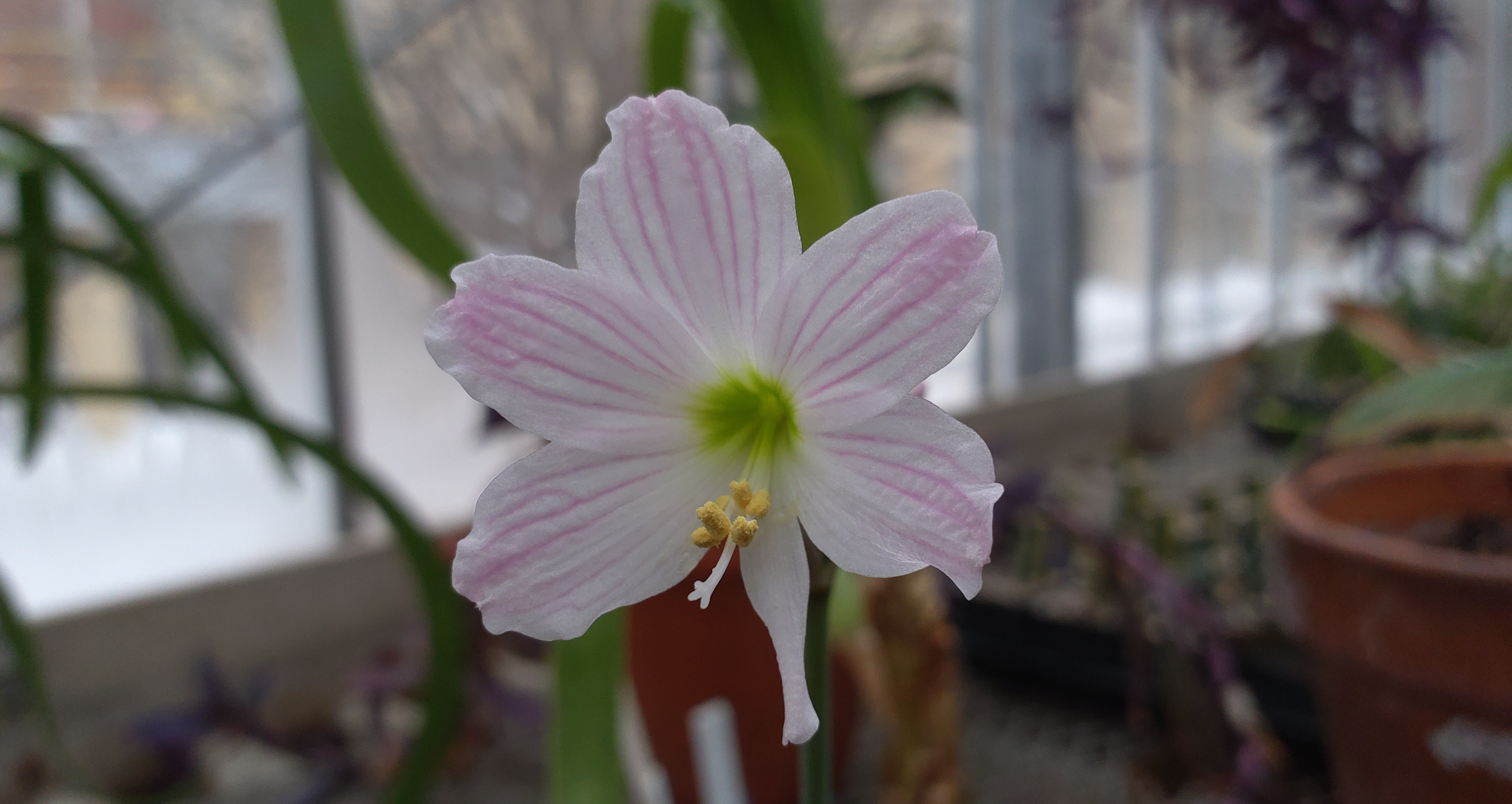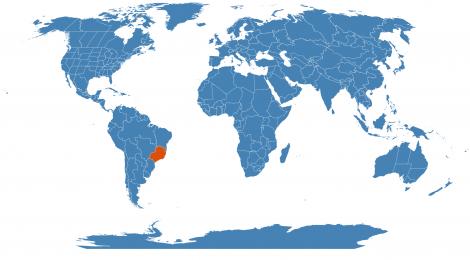Accession Data:
Hippeastrum idimae Dutilh & R.S.Oliveira
- Common Name:
- Family: Amaryllidaceae J. St-Hil.
- Description: Bulb ca. 2.5–3.5 cm long, oval to round, subterraneous. Leaves up to 10–15(–20) × 1.2–2.3 cm, narrower at the base and broader at the distal third part, resulting in a slightly spatulated form, similarly green colored abaxially and adaxially. Inflorescence 1–7 flowers in different stages of maturity; scape 14–30 cm long; spathe with 2 free bracts, 1.4–3 cm long. Flowers with pedicels 0.8–3.2 cm long at anthesis, with different lengths in flowers of the same inflorescence; hypanthium tube 0.4–0.6 cm long, with many fimbriae, 0.1–0.2 cm long, above the junction of the filament with the tepals; tepals white with longitudinal rose colored to magenta stripes and yellowish green base; upper sepal 3.2–4.5 × 0.9–1.6 cm, lower sepals 3–4.2 × 0.5–1.3 cm, upper petals 3–4.3 × 0.4–0.9 cm, lowermost petal 2.7–3.7 × 0.2–0.4 cm. Stamen filaments 1.7–2.8 cm long, in two or three different lengths; pollen cream colored. Ovary trilocular, 0.2–0.4 cm long; style 2.7–3.6 cm long ascending distally; stigma trifid, with lobes 0.1–0.2 cm. Fruit trilocular, 1.4–2.1 × 0.4–0.8 cm dehiscent dry capsule, flat winged seeds 0.4–0.6 cm, dark brown to black. 2n = 22 chromosomes.2
The flowers of Hippeastrum idimae have a very unique morphology; they resemble closely Eithea blumenavia, in color, shape and in the corona type, being the smallest flowers found in Hippeastrum. The leaves are also narrow near the base, resembling the leaves of Eithea and of some Griffinia, but they grow more prostrate than in these genera. The main external morphological difference, however, lies in the seeds, which are round and with an expansion in Eithea and in Griffinia, flat and winged in Hippeastrum, with the exception of H. reticulatum Herbert (1824: sub t. 2475), that has completely round black seeds, without any expansion.2
- Culture: The species enjoy a rich and well-drained medium with lots of good filtered sunlight and fertilizer during the growing season. It has a winter dormancy in which it should be kept more dry.1
Accession Data:
- Accession # 201600169
- Source: Rick Buell
- Provenance:
Rcvd as Hippeastrum "Cardoza Moriera" Rick Buell ex seed from private party ex Cardoso Moreira NOV2016 - Presumed (for now) to be "Hippeastrum sp. ex Cardoso Moreira is a miniature species that has not yet been named. It comes from the city of Cardoso Moreira in the state of Rio de Janeiro, Brazil. Phylogenetically it falls basal to the other Hippeastrum species, to be interpreted as a more "primitive" member of the genus."1 MAY 2017 - Name published in Phytotaxa Vol 307, No 2.
- Accession Date: 11-28-2016
- Bench: 3319 - ZING:Canna & Musa
- Currently: active - healthy
- Qty: 2 confirmed on 02-17-2025
Classification:
- Division: Magnoliophyta
- Class: Liliopsida
- SubClass: monocots
- Order: Asparagales
- SubOrder:
- Family: Amaryllidaceae
- SubFamily: Amaryllidoideae
- Tribe: Hippeastreae
- SubTribe: Hippeastrinae
Flowering Data:
This accession has been observed in bloom on:| Year | Jan | Feb | Mar | Apr | May | Jun | Jul | Aug | Sep | Oct | Nov | Dec | ||||||||||||||||||||||||||||||||||||||||
|---|---|---|---|---|---|---|---|---|---|---|---|---|---|---|---|---|---|---|---|---|---|---|---|---|---|---|---|---|---|---|---|---|---|---|---|---|---|---|---|---|---|---|---|---|---|---|---|---|---|---|---|---|
| 2025 | ||||||||||||||||||||||||||||||||||||||||||||||||||||
| 2024 | ||||||||||||||||||||||||||||||||||||||||||||||||||||
| 2023 | ||||||||||||||||||||||||||||||||||||||||||||||||||||
| 2022 | ||||||||||||||||||||||||||||||||||||||||||||||||||||
| 2021 | ||||||||||||||||||||||||||||||||||||||||||||||||||||
| 2020 | ||||||||||||||||||||||||||||||||||||||||||||||||||||
| 2019 | ||||||||||||||||||||||||||||||||||||||||||||||||||||
References (internal):
- EEB Greenhouse Holdings native to: Brazil Southeast
References (external):
-
Hippeastrum Species Two at Pacific Bulb Society. Last accessed on Tuesday, November 29, 2016.
- Oliveira, Renata S.; Urdampilleta, Juan D.; Dutilh, Julie H.A..A new Hippeastrum (Amaryllidaceae) species from Brazil in Phytotaxa, [S.l.], v. 307, n. 2, p. 147-152, may 2017. ISSN 1179-3163. Last accessed on Tuesday, May 23, 2017.
- Angiosperm Phylogeny Website at MoBot. Last accessed on Tuesday, 03 December, 2019.
data regenerated on Wed, 04 Jun 2025 15:52:58 -0400 [bcm v4.0]
Images:

Additional images for this accession:
Click on thumbnails to enlargeCurrent Accessions in the Amaryllidaceae
Subfamily Agapanthoideae
Subfamily Allioideae
Tribe Allieae
Subfamily Allioideae
Tribe Tulbaghieae
Subfamily Amaryllidoideae
Tribe Amaryllideae
- Amaryllidinae: Amaryllis belladonna

- Crininae: Crinum asiaticum


- Crininae: Crinum macowanii W/C
- Crininae: Crinum moorei

- Strumariinae: Brunsvigia striata W/C
- Strumariinae: Nerine bowdenii

- Strumariinae: Nerine krigei W/C

- Strumariinae: Nerine laticoma W/C

- Strumariinae: Nerine masoniorum W/C

- Strumariinae: Nerine rehmannii

- Strumariinae: Strumaria sp. W/C
Subfamily Amaryllidoideae
Tribe Cyrtantheae
Subfamily Amaryllidoideae
Tribe Eucharideae
Subfamily Amaryllidoideae
Tribe Galantheae
Subfamily Amaryllidoideae
Tribe Griffineae
Subfamily Amaryllidoideae
Tribe Haemantheae
- Clivia miniata


- Clivia miniata


- Gethyllis gregoriana
- Haemanthus albiflos

- Haemanthus carneus

- Haemanthus humanii W/C

- Haemanthus humilis W/C

- Scadoxus membranaceus

- Scadoxus multiflorus ssp. Katherinae


Subfamily Amaryllidoideae
Tribe Hippeastreae
- Hippeastrinae: Hippeastrum hybrid

- Hippeastrinae: Hippeastrum idimae


- Hippeastrinae: Hippeastrum mandonii


- Hippeastrinae: Hippeastrum papilio

- Hippeastrinae: Rhodophiala bifida

- Zephyranthinae: Habranthus robustus


- Zephyranthinae: Habranthus sp.
- Zephyranthinae: Sprekelia formosissima


- Zephyranthinae: Zephyranthes candida


- Zephyranthinae: Zephyranthes minima

- Zephyranthinae: Zephyranthes rosea

Subfamily Amaryllidoideae
Tribe Hymenocallideae
Subfamily Amaryllidoideae
Tribe Lycoridae
Subfamily Amaryllidoideae
Tribe Narcisseae
Subfamily Amaryllidoideae
Tribe Pancratieae
Subfamily Amaryllidoideae
Tribe Stenomesseae
W/C = Wild Collected
 = indicates flowering in past 14 days
= indicates flowering in past 14 days
 = images available for this accession
= images available for this accession
 = map available for this accession
= map available for this accession
 = accession added within past 90 days
= accession added within past 90 days
